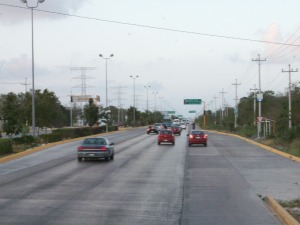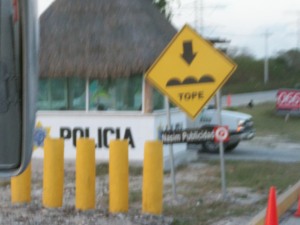I couldn't believe my eyes as we left the Cancun International Airport. A divided highway with overhead lights on the median. Not only in the city , but in the country stretching for many kilometers. The highway was well marked, well signed, well maintained and in most ways as safe as any other north American Highway.
[caption id="attachment_503" align="aligncenter" width="300" caption="Good Highway in Mexico South of Cancun"]
 [/caption]
[/caption]Illuminated LEDs embedded in the roadway guided vehicles to merge. it was impressive even if this tourist highway was not typical of highways elsewhere in mexico.
This highway was a "1/2 freeway" not Interstate standards, but pretty close.
The highway was limited access, had some at grade crossings as well as overpasses. Also seperating it from freeway standard was the provision of the uturn "retournos" where traffic could exit the fast lane, turn around and enter the opposite fast lane. The roadways in mexico often use metal speedbumps embeeded at different interfals where traffic is expected to stop for a police check or an at grade intersection.
[caption id="attachment_505" align="aligncenter" width="300" caption="Mexican Police checkpoint"]
 [/caption]
[/caption]I noticed other modes of transportations in cities. Playa del Carmen had more scooters than I'm used to. and more bicycles. Playa had dedicated bidirectional bicycle lanes seperated from traffic by a curb. Practical tricycles pedalled by union tricyclests carry many local deliveries.
Taxis (Playa is a tourist area) are plentiful as well as busses and collectivos. The taxis were similar to anywhere else except for the reputation that Mexican taxi drivers have for being daring. Taxis are not metered there, so negotiate your price before you get it and pay when you get there.
The busses are like the greyhound or charger coaches seen in Canada and USA. Plush seats, airconditioning, TVs, curtains (some seatbelts). Taking a 20 minute ride between towns cost only $1.80 which is a bargain considering a similar trip would cost $5-15 in Canada. It seems that those busses run very regularly. Hourly or every 15 minutes. In Canada you are lucky to get 1/2 a dozen busses in a day. So as a Canadian I can't help feel like we are being ripped off here. A poorer country like Mexico can make nice regular cheap bus service an option? (Maybe everybody owning a car up here has made that a difficult challenge for the operators here?) I wonder what I'm missing here?
Mexico has something special I haven't seen elsewhere in North america. Collectivos are 15 passenger vans that operate somewhere between bus and taxi. Heading down the freeway they will pick up people who need a lift as long as there is room left. When full, the collectivo will travel at alarming speeds to get you to your destination and it becomes more like a taxi at that point, leaving main roads to drop you at your destination.
[caption id="attachment_504" align="aligncenter" width="300" caption="Collectivo"]
 [/caption]
[/caption]Those are the neat observations I made about Mexican transportation. Thanks for listening, I'm glad I could share some of the things that impressed and surprised me.
Peace
Greg.
No comments:
Post a Comment